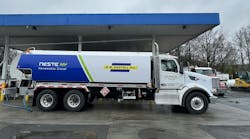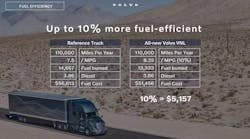It is fair to say that natural gas has become the darling of the alternative fuel world, at least for now. The price differential between natural gas and diesel or gasoline is compelling, as is the fuel’s “green” emissions profile and the fact the U.S. is producing a lot of it right now.
According to a recent survey conducted by ACT Research and Transport Capital Partners, the love affair with natural gas is in full bloom. “The survey confirms the growing interest in natural gas by carriers encouraged by the large difference in [fuel] price,” the survey report notes. “Slightly over half of the fleets surveyed are considering adding natural gas trucks to their fleet next time they purchase new vehicles, but [it] also shows the complexities of choices in terms of type of fuel, fuel supply systems, payload impact, station availability, and so forth.”
It is that darned “and so forth” that has plagued fleets poised on the brink of adding natural gas trucks to their operation. For starters, fleets accustomed to running diesel have to decide if they are interested in compressed natural gas (CNG) or liquid natural gas (LNG)-powered trucks.
CNG or LNG?
CNG, in spite of its shorter operating range and generally lower GVW limitations, has enjoyed an early lead over LNG in on-road trucking applications. For many local and even regional operations, it can be a rightsized solution for everything from beverage delivery vehicles to transit buses, sanitation trucks to the pickups in use by the parks department.
For fleets with longer-haul operations, however, LNG may be the only viable natural gas choice. LNG is condensed into a liquid at close to atmospheric pressure by cooling it to about -260 deg. F. This gives LNG a higher energy density than CNG, or about 60% that of diesel fuel. It also makes it easier to carry more fuel onboard.
The Center for Liquefied Natural Gas states that “LNG requires only 30% of the space of compressed natural gas to store the same amount of energy.” LNG must be stored in thermally insulated storage tanks, though. The engine then heats the LNG, converting it back into a gas for power.
Dedicated, dual or mixed?
In addition to selecting LNG or CNG, there are various types of natural gas engines available, each with different performance characteristics. For example, “dedicated” natural gas engines run only on natural gas, while “mixed fuel” engines blend natural gas with diesel or other fuels. “Dual fuel” systems blend natural gas with diesel by injecting it into the turbocharger; however, the vehicle can still run on 100% diesel. That means you can still keep going even if you run out of natural gas.
In practice, there are some engines, like the Cummins Westport ISX, that use a small amount of diesel but basically act as dedicated natural gas engines. And some engines, like the spark-ignited Cummins Westport ISL G, can operate on either CNG or LNG.
The good news about dedicated natural gas vehicles is that you don’t need to worry about buying two different fuels or about mandated emissions aftertreatment systems as in the case of diesel, but it limits your practical operating range. The good news about dual-fuel vehicles is that so-called “range anxiety” goes away.
The U.S. Dept. of Energy states that “natural gas vehicles are similar to gasoline or diesel vehicles with regard to power, acceleration and cruising speed.”
In heavy-duty vehicles, dual-fuel, compression-ignited engines are slightly more fuel-efficient than spark-ignited, dedicated engines; however, a dual-fuel engine increases the complexity of the fuel-storage system by requiring storage of both types of fuel.”
OEM or retrofit?
Many truck OEMs are now offering new LNG and CNG vehicles that can be purchased through a truck dealership. Most light- and medium-duty CNG vehicles in operation today, though, are a result of a natural gas conversion or retrofit, according to CNG Now, a website sponsored by companies in the natural gas industry.
Installers will usually only perform a CNG conversion on new or nearly new vehicles, CNG Now notes, and they use CNG “conversion kits” to do that. These kits must meet EPA and/or CARB requirements. Different states have different requirements, so you will want to make sure you know what the requirements are in your area before moving ahead with a conversion.
Andy Douglas, national sales manager for specialty markets at Kenworth Truck, recently prepared a brief guide to help fleets considering natural gas. He stresses the importance of taking into account the operating range for natural gas. “In general, if your operating range is over 400 mi., it is usually best to go with LNG,” Douglas says. “Under 400 mi., CNG can be an option.”
As such, the location of fueling facilities is an important consideration. Fleets can utilize public facilities or build their own, both of which have their advantages. Weight is also a concern, as natural gas fuel tanks can add as much as 300 to 600 lbs. to the vehicle in the case of CNG storage. It is particularly important to consider the load you have to carry, according to Douglas. “CNG can be used up to 66,000 lbs. GVW, with some severe-duty applications going up to 80,000 lbs. GVW,” he says.
Natural gas fuel tanks also take up more real estate on the frame rails, so placement of tanks can be a challenge. Douglas recommends carefully considering “the possible impact of tank placement choices on wheelbase length, weight distribution and turning radius.”
There is sometimes a tendency to over-spec when choosing natural gas fuel tanks, he remarks, since operators are in the habit of carrying a two- or three-day supply of diesel onboard. “In many cases, it is often impractical to carry much more than a day’s supply of natural gas,” Douglas says. “Natural gas fuel tanks can also be expensive, so consider carrying only enough fuel for a full day’s work, plus a 10% reserve.”
Maintenance also requires special considerations. If you do your own maintenance, your shop will require some upfitting to make it safe to service natural gas trucks.
When to trade?
Operating natural gas trucks requires a little extra planning when it comes to trade cycles, too. Chesapeake Energy began converting its entire fleet of almost 6,000 vehicles to run on CNG in late 2007. “We trade our vehicles at 90,000 mi., while they are still under powertrain warranty,” says Nate Pumphrey, director of fleet operations for the company.
“We are cycling them back pretty early, we know,” he adds. “There is a temptation to keep them longer for the fuel cost-saving benefit, but it is a balancing act when you factor in maintenance. The CNG vehicles require an additional filter change. And every three years, the fuel tanks have to be inspected and recertified.”
While diesel trucks are famous for running a million miles or more, there is less history available about the lifespan of natural gas trucks. Just another consideration that needs to be factored into any decision before purchasing natural gas vehicles.


